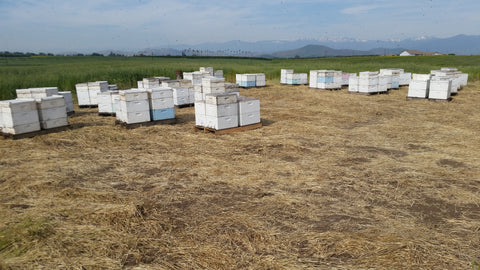Honey Bees
Everyone knows that honey bees make honey, but their contributions hardly end there. One third of the U.S. food diet is derived from insect-pollinated plants and honey bees are responsible for an impressive 80 percent of that process. Honey bees are critical to the health of our planet and our food supply, so beekeepers are careful to apply best management practices that support bee health.
While honey bees are foraging flower to flower for pollen and nectar, they are by accident fertilizing these flowers; transferring pollen from male to female flower. Pollen is collected by the honey bees legs and stored in pollen sacks on the outside of their bodies(pictured below). Honey bees lick the nectar from the flowers by using their Proboscis (tongue), and store this nectar inside one of their bodies two honey stomachs.

Honey bees live in colonies that are most often maintained by beekeepers. The modern bee hive is made up of 8-10 frames per box (pictured below).

Honey bees fill these frames with collected pollen and nectar from all flowers they visited. Collected pollen is made into "bee bread", stored in individual cells on the frames, and consumed by the bees as a protein source when no natural pollen is available. Nectar is stored directly into cells on the frames, then the bees fan out the excess moisture. Nectar changes its name to honey once the moisture level reduces to 17% or less. The bees finish this process by capping every honey filled cell with beeswax. Honey is the only food that will never spoil and requires no refrigeration.
As the colony population grows in Spring and early Summer months, beekeepers will add additional boxes to maximize this population increase (pictured below).

Most commercial beekeepers place 4 to 6 hives on special pallets to help with migratory transportation (pictured below)

Every successful honey bee colony is populated with one queen, approximately 98% worker bees, and approximately 2% drones bees.

The Queen Bee is the largest bee in the colony and her only function is to lay up to 2,500 eggs per day for entire 2 to 3 year life. The queen bee has a barbless stinger, which she will only use to defend herself against another queen bee. The queen bee never feeds herself, and instead relies on her daughters(worker bees) to feed her Royal Jelly for nutrition.
Worker bees are unfertilized female bees and are the smallest bees in the colony. A colony may have as few as 5,000 workers bees during Winter months, and as many as 80,000 worker bees during late Spring and Summer months. Life expectancy of worker bees is approximately 21 days during Spring-Summer months, and approximately 4 months during Winter. Worker bees are responsible for collection of all food for the colony(pollen and nectar), feeding the queen and larvae Royal Jelly, guarding the hive entrance from intruders, regulating temperature within the colony, and building and maintenance of wax cells(comb). Worker bees also collect propolis; a residue from tree sap used to seal cracks and coat the inside of the colony. Worker bees have a barbed stinger which allows the stinger to remain attached to the surface of intruders while venom is continuously pumped in.
Drone (male) Bees have no stinger and have only one function in the colony, mate with the queen in flight. Drones can live up to 90 days or until they mate with a queen. All remaining drones are removed by the worker bees in preparation for Winter season in order to preserve stored pollen and honey.
Location, location, location... Managing honey bees means keeping them alive, which means having various places to put them throughout the year. Beekeepers utilize various locations for specific reasons; honey and pollen production, winter yards, loading-unloading yards, queen mating yards, etc.



We are always in need of additional places to keep and manage our honey bees throughout the year, and we will gladly compensate for use of leased open or production locations. Call or email Mike at 559-974-4042 or manddhoney@gmail.com
Fun Facts
-The honey bee, Apis Mellifera, is the only insect that produces food; which is further consumed by humans, animals, and other insects.
-A worker bee can fly up to 5 miles and as fast as 15 miles per hour.
- A worker bee can visit up to 100 flowers during one foraging flight.
-Worker bees have two stomachs; one for eating with, one for storage of nectar and water.
-The average worker bee will make one twelfth of a teaspoon of honey in her lifetime.
- Composition of honey is approximately 83% sugars and 17% water.
-Worker bees produce beeswax from eight paired glands on the underside of their abdomen.
-The honey bees wings stroke 11,400 times per minute, thus making their distinctive buzzing sound.
-The worker bee will use her stinger only for defensive situations and is considered to be a social insect.
-Honey bees must maintain a temperature of 92-94 degrees Fahrenheit inside their colonies brood nest area, regardless of the climate outside the colony.
-The queen bee must mate with up to 20 drones within a 10 day period of being born to ensure a successful long egg laying life of 2-3 years.
-Fermented honey, known as Mead, is the most ancient fermented beverage.


